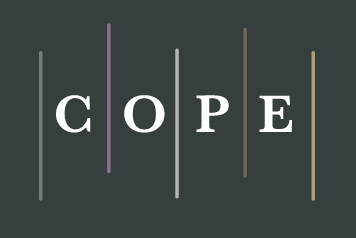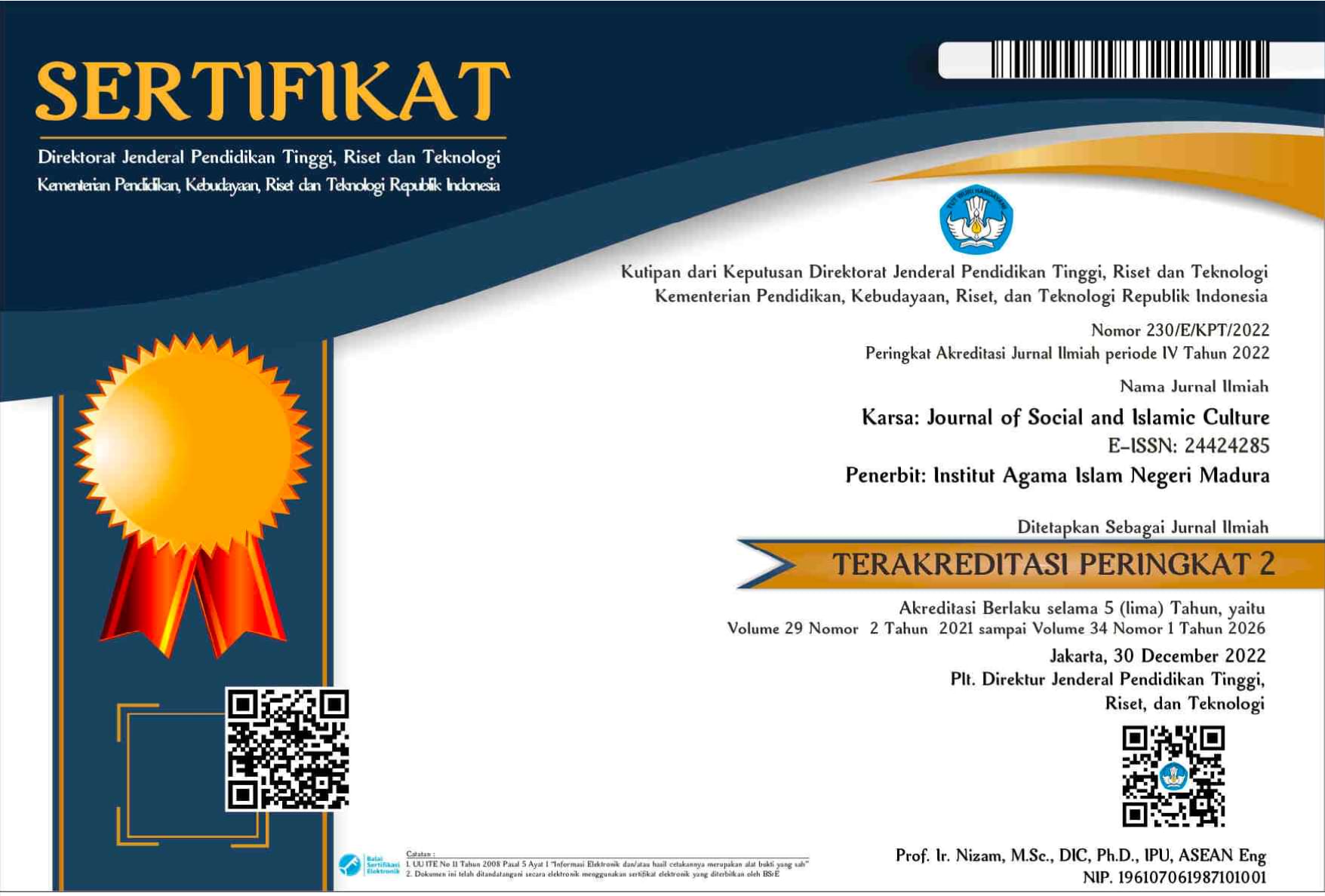Verbal and Symbolic Aggression Female in The Madurese Culture
 Abstract views: 330
,
Abstract views: 330
,
 PDF downloads: 255
PDF downloads: 255
Abstract
This research explores the verbal and symbolic aggression of Madurese women students. These two things will be examined as the leading models by looking at the oral and symbolic aggression models for Madurese women. Women’s aggression is a complex form of behavior. This complexity is essential to the cyclical activities of the self and its environment. Madurese women ‘do not have a voice’ in voicing their own opinions including in rural electoral power politics and household economic autonomy. This research uses mixed methods, quantitative and qualitative. Quantitative research uses statistical analysis using confirmatory factorial analysis (CFA), while qualitative research uses descriptive data about the types and forms of verbal aggression in women. Both explore verbal and symbolic tendencies of aggression in Madurese women. The women involved were students at universities in Madura. The research results show that women prefer symbolic aggression to verbal aggression. Women with higher education prefer symbolic aggression to verbal aggression. Types and forms of verbal aggression include cha’-nguca’e, hitting, pulling, harming, and injuring. This oral does not lead to the loss of another person's life. Another finding is that a symbolic attack always follows every verbal aggression. Meanwhile, symbolic aggression involves gossip, talking about bad things about other women with slander and backbiting, spitting on other people’s property rights, inviting other people to hate other women, constantly talking about other people’s bad things, looking for reasons to hate other people, not coming meeting with hated people.
Downloads
References
Adorno, T.W., E. Frenkel-Brunswik, D.J. Levinson, and Sanford, R.N. The Autoritarian Personality. Edited by Harper Brothers. New York, 1950.
Ahsan, Mohammad. “Physical, Verbal, Anger and Hostility Aggressiveness in Universitys Physical Education Students.” International Journal of Sports and Physical Education 1, no. 2 (2015): 20–23.
Ami N Wani, Mohammad. “Aggression among Annamalai University Students.” Global Journal of Intellectual & Developmental Disabilities 1, no. 3 (2018). https://doi.org/10.19080/gjidd.2017 .01.555562.
Appel, Markus. “Internet Use and Verbal Aggression: The Moderating Role of Parents and Peers.” Computer in Human Behavior 33 (2014): 235–41. https://doi.org/10.1016/j.chb.2014.01.007.
Appel, Markus. “Internet Use and Verbal Aggression: The Moderating Role of Parents and Peers.” Computers in Human Behavior 33 (2014): 1–32.
Archer, John, and Sarah M. Coyne. “An Integrated Review of Indirect, Relational, and Social Aggression.” Personality and Social Psychology Review 9, no. 3 (2005): 212–30. https://doi.org/10. 1207/s15327957pspr0903_2.
Azwar, Saifuddin. Sikap Manusia. Yogyakarta: Pustaka Pelajar, 2009.
Banister, Peter, E. Burman, I. Parker, M. Taylor, and C. Tindall, Qualitative Methods in Psychology. Philadelphia: Open University Press, 1994.
Berkowitz, L. Affect, Aggression, and Antisocial Behavior. Edited by & H. H. Goldsmith In R. J. Davidson, K. R. Scherer. Oxford: Oxford University Press, 2003.
Bond, Michael Harris. “Culture and Aggression-From Context to Coercion.” Personality and Social Psychology Review 8, no. 2004 (2004): 62–78. https://doi.org/10.1207/S15327957PSPR0801.
Bouvier, Helene. Lebur! Jakarta: Yayasan Obor Indonesia, 2002.
Buss, Arnold H, and Mark Perry. “The Aggression Questionnaire.” Journal of Personality and Social Psychology 63, no. 3 (1992): 452–59. https://doi.org/10.1037/0022-3514.63.3.452.
Campbell, Anne, and Catharine Cross. “Women and Aggression.” In The Oxford Handbook of Evolutionary Perspectives on Violence, Homicide, and War. New York: Springer Publishing Company, 2014. https://doi.org/10.1093/oxfordhb/9780199738403.013.0012.
Chou, Shih Yung. “Millennials in the Workplace: A Conceptual Analysis of Millennials’ Leadership and Followership Styles.” International Journal of Human Resource Studies 2, no. 2 (2012): 71. https://doi.org/10.5296/ijhrs.v2i2.1568.
Creswell, John W. Research Design: Qualitative, Quantitative, and Mixed Method. Research Design Qualitative Quantitative and Mixed Methods Approaches. California: Sage, 2014. https://doi.org/10.1007/s13398-014-0173-7.2.
Diego, San, and Douglas Stone. Praise for 50 Psychology Classics. USA Today, 2007. http://books.google.com/books?hl=en& lr=&id=wfjB9Blnk8kC&oi=fnd&pg=PA9&dq=50+Psychology+Classics&ots=2Rt43IrH3q&sig=yE6kTzJRpz95UpANdEmWwCdz1qo.
Effendy, Bisri. An Nuqayah: Gerak Transformasi Sosial Di Madura. Jakarta: P3M, 1990.
Gillett, Kyle Stephen. Parental and Religious Influences on Adolescent Empathy and Antisocial Behavior Among Latino and Euro-American Youth: An Investigation of Mediating and Moderating Effect. Dissertation. Texas: Texas Tech University, 2006.
Grace-Bridges, Re’Shanda. “Generation Z Goes to College.” Journal of College Orientation, Transition, and Retention 25, no. 1 (2019). https://doi.org/10.24926/jcotr.v25i1.2919.
Hale et.al. "The Theory of Reasoned Action." Theory & Psychology, 2009. https://doi.org/10.1177/0959354309336319.
Haliq, Fathol. Kepercayaan dan Konflik Interpersonal pada Masyara-kat Madura. Yogyakarta: Program Pascasarjana Psikologi UGM, 2004.
Haliq, Fathol. “Pemberdayaan Remaja Pesisir Dan Deprivation Trap Komunitas Pesisir Madura.” Pamekasan: IAIN Madura, 2019.
Hamzy, Aryati, Cheng-Chung Chen, and Kuan-Ying Hsieh. “Mental Health and Aggression in Indonesian Women.” Behavioral Sciences 13, no. 9 (2023): 727. https://doi.org/10.3390/bs13090 727.
Hidayati, Tatik. “Kalebun Bebinik (Kontruksi Budaya Masyarakat Madura Dalam Melestarikan Kekuasaan).” KARSA 22, no.2 , (Desember 2014): 150-60. http://ejournal.iainmadura.ac.id/index. php/karsa/article/view/525.
Hidayati, Tatik. Ngala’ Tompangan: Perlawanan Perempuan Terha-dap Kawin Anak. Yogyakarta: Cahaya, 2018.
Hidayati, Tatik. Representasi Sosial Perempuan Buruh Garam. Sume-nep: INSTIKA, 2018.
Hout, Wiljo J P J van, and Paul M G Emmelkamp. “Exposure in Vivo Therapy.” Encyclopedia of Psychotherapy, 2002, 761–68. https://doi.org/10.1097/01.mlr.0000444705.02554.87.
Jiang, Jun, Kira Bailey, Antao Chen, Qian Cui, and Qinglin Zhang. “Unconsciously Triggered Emotional Conflict by Emotional Facial Expressions.” PLoS ONE 8, no. 2 (2013): 1–8. https://doi. org/10.1371/journal.pone.0055907.
Joireman, Jeff, Jonathan Anderson, and Alan Strathman. “The Aggression Paradox: Understanding Links Among Aggression, Sensation Seeking, and Consideration of Future Consequences.” Journal of Personality & Social Psychology 86, no.6 (2003): 1287–1302. https://www.scirp.org/%28S%28i43dyn45teexjx45 5qlt3d2q%29%29/reference/referencespapers.aspx?referenceid=1088560
Jonge, Huub de. Across Madura Strait. Leiden: KITLV Press, 1995.
Jonge, Huub de. Agama, Kebudayaan Dan Ekonomi. Jakarta: Rajawali Press, 1989.
Keskin, Özlem. “Investigation of Aggression Levels of University Students (Kocaeli University Case).” Asian Journal of Education and Training 4, no. 3 (2018): 186–96. https://doi.org/10.20448/ journal.522.2018.43.186.196.
Kiani, Behnaz, Seyed Mohsen Hojatkhah, and Mohammad Torabi-nami. “Family Functioning, Identity Formation, and the Ability of Conflict Resolution Among Adolescents.” Contemporary School Psychology, 2016, 392–401. https://doi.org/10.1007/ s40688016-0097-7.
Kuntowijoyo. Perubahan Sosial Dalam Masyarakat Agraris Madura 1850-1940. Jogjakarta: Mata Bangsa, 2002.
Lange, PAM van. “Aggression and Violence Around the World: A Model of CLimate, Aggression, and Self-Control in Humans (CLASH).” Behavioral and Brain Sciences (2016): 1–63. https://doi.org/10. 1017/S0140525X16000406.
Lisa Legault, “Encyclopedia of Personality and Individual Dif-ferences.” Encyclopedia of Personality and Individual Differences, no. October (2016). https://doi.org/10.1007/978-3-319-28099-8.
Leschied, Alan W., Anne Cummings, Michele Van Brunschot, Alison Cunningham, Angela Saunders. Female Adolescent Aggression : A Review of the Literature and the Correlates of Aggression, Canada: Public Works and Government Services Canada, 2000. https://www.publicsafety.gc.ca/cnt/rsrcs/pblctns/fml-adlscnt-aggrssn/fml-adlscnt-aggrssn-eng.pdf.
Lestari, Sri. Psikologi Keluarga: Penanaman Nilai, Penanganan Konflik Dalam Keluarga. Jakarta: Kencana, 2005.
Mansurnoor, Iik Arifin. Islam in an Indonesian World Ulama’ of Madura. Yogyakarta: Gadjah Mada University Press, 1990.
Marcus, Robert F. Aggression and Violence in Adolescence. Cambridge: Cambridge University Press, 2007.
Marte, Ricardo M. Adolescent Problem Behaviors: Delinquence, Aggression, and Drug Use. New York: LFB Scholarly Publishing, 2008.
Martínez, Cristhian A., Jan Willem van Prooijen, and Paul A.M. Van Lange. “A Threat-Based Hate Model: How Symbolic and Realistic Threats Underlie Hate and Aggression.” Journal of Experimental Social Psychology 103, no. July (2022): 104393. https://doi.org/10.1016/j.jesp.2022.104393.
McAndrew, Francis T. “The ‘Sword of a Woman’: Gossip and Female Aggression.” Aggression and Violent Behavior 19, no. 3 (2014): 196–99. https://doi.org/10.1016/j.avb.2014.04.006.
Monks, FJ. Psikologi Perkembangan. Yogyakarta: UGM Press, 2006.
Nazir, Amber, and Humaira Mohsin. “Coping Styles, Aggression and Interpersonal Conflicts among Depressed and Non-Depressed People.” Health Promotion Perspectives 3, no. 1 (2013): 80–89. https://doi.org/10.5681/hpp.2013.010.
Niehof, Anke. Women and Fertility in Madura. Leiden: SN, 1985.
Ohbuchi, Ken-Ichi. “Personality and Interpersonal Conflict: Aggressiveness, Situational Variables.” International Journal of Conflict Management 8, no. 2 (1997): 99–113. https://www. researchgate.net/publication/235263896_Personality_and_interpersonal_conflict_Aggressiveness_self-monitoring_and_situational_variables.
Palmen, Désiré G.C., Emile W. Kolthoff, and Jan J.L. Derksen. “The Need for Domination in Psychopathic Leadership: A Clarification for the Estimated High Prevalence of Psychopathic Leaders.” Aggression and Violent Behavior 61 (2021). https://doi.org/10. 1016/j.avb.2021.101650.
Perdiansyah, Vicky. Konflik Intrapersonal Anggota Keluarga. Yogyakarta: UIN Sunan Kalijaga, 2015.
Pribadi, Yanwar. “Islam and Politics in Madura: Ulama and Others Local Leaders in Search of Influence 1990-2000,” (2013): 340. https://openaccess.leidenuniv.nl/handle/1887/21539.
Rifai, Mien Ahmad. Manusia Madura. Yogyakarta: Pilar Media, 2007.
Rozaki, Abdur. Menebar Kharisma Menuai Kuasa. Yogyakarta: Pustaka Marwa, 2003.
Scott, James C. Domination and the Art of Resistance: Hidden Transcripts. London: Yale University Press, 1990.
Sturmey, Peter. The Wiley Handbook of Violence and Aggression. New York: John Wiley & Sons Ltd., 2017.
Sudagung, Hendro Suroso. “Migrasi Swakarsa Orang Madura Ke Kalimantan Barat.” Yogyakarta: Disertasi Ilmu Sosial Politik UGM, 1984.
Sultana, A.M. “Factors Effect on Women Autonomy and Decision-Making Power within the Household in Rural Communities.” Journal of Applied Sciences Research 7, no. 1 (2011): 18–22. https://www.researchgate.net/publication/228505951_Factors_Effect_on_Women_Autonomy_and_Decision-Making_Power_ within_the_Household_in_Rural_Communities.
Sydney-agbor, Ngozi Nwakaego. “Impact of Religiosity, Family Relations, and Gender on Aggressive Behaviours among Undergraduates.” International Journal of Social Science and Humanity 6, no. 1 (2016): 42–46. https://doi.org/10.7763/IJSSH. 2016.V6.615.
Vlaicu, Claudia. “Psychological Theories of Aggression. Critical Perspective.” Journal of Education, Society and Multicultura-lism, (2020), 61–73. https://www.jesm.ro/wp-content/uploads/ 2021/02/7.ClaudiaVlaicu_JESM-2019-converted.pdf.
Walgito, Bimo. Psikologi Sosial. Yogyakarta: UGM Press, 2007.
Warburton, Wayne A., and Craig A. Anderson. Aggression, Social Psychology. International Encyclopedia of the Social & Behavioral Sciences: Second Edition. Second Edi. Elsevier, 2015. https://doi.org/10.1016/B978-0-08-097086-8.24002-6.
Wiyata, Latief. Carok: Institusionalisasi Kekerasan Dan Harga Diri Orang Madura. Yogyakarta: LKiS, 2002.
Wiyata, Latief. Mencari Madura. Jakarta: Bidik Phronesis Publishing, 2013.
The journal operates an Open Access policy under a Creative Commons Non-Commercial Share-Alike license. Authors who publish with this journal agree to the following terms:
- Authors retain copyright and grant the journal right of first publication with the work simultaneously licensed under a Creative Commons Attribution License that allows others to share the work with an acknowledgement of the work's authorship and initial publication in this journal.
- Authors are able to enter into separate, additional contractual arrangements for the non-exclusive distribution of the journal's published version of the work (e.g., post it to an institutional repository or publish it in a book), with an acknowledgement of its initial publication in this journal.
- Authors are permitted and encouraged to post their work online (e.g., in institutional repositories or on their website) prior to and during the submission process, as it can lead to productive exchanges, as well as earlier and greater citation of published work.





















